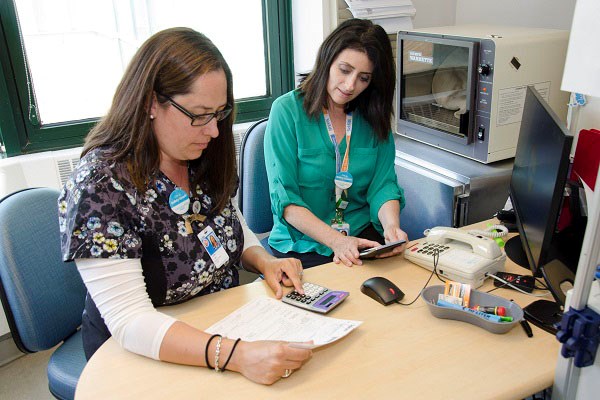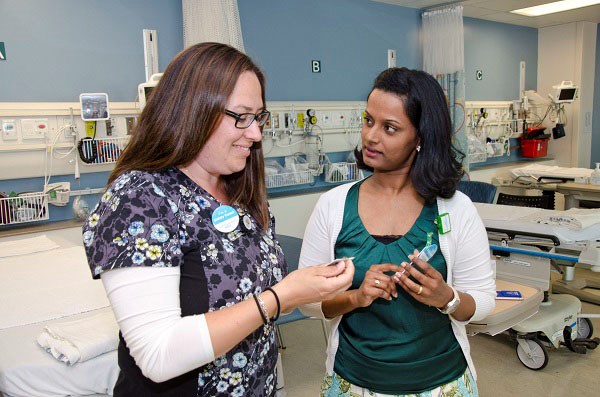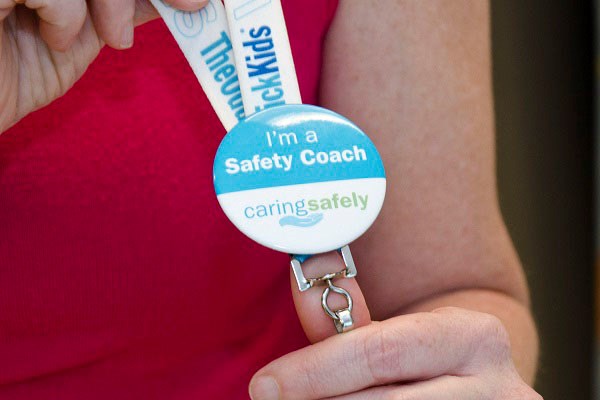Safety coaches are helping us to care safely everywhere, every day
Summary:
As part of the Caring Safely initiative over 85 per cent of staff at SickKids have completed error prevention training. But we know that just like trying a new sport, learning new skills and techniques at work can be challenging. With so many priorities, it can be difficult to integrate what you've learned in a class in your work routines. That's where Safety Coaches come in.
As part of the Caring Safely initiative over 85 per cent of staff at The Hospital for Sick Children (SickKids) have completed training in error prevention techniques to improve patient safety. But we know that just like trying a new sport, learning new skills and techniques at work can be challenging. With so many priorities, it can be difficult to integrate what you’ve learned in a class in your work routines. That’s where Safety Coaches come in. This week is Canadian Patient Safety Week, so we’re recognizing the important role these staff have to play in our safety journey.
Safety Coaches are staff who have received additional training in error prevention and the use of the four expected safety behaviours and associated tools. Based on a peer feedback and coaching model, safety coaches act as experts who review the tools with their peers, observe their use, and provide both positive reinforcement and constructive criticism when they observe missed opportunities.
“The coaching program is really exciting because it’s the final piece in the puzzle to really ensure everyone is speaking the same language of safety. Looking at our work through a lens of safety, together with these tools, we’re all able to communicate clearly with each other and are working together towards the same goal, which is keeping our patients safe and reducing preventable harm,” says Jennifer McLean, Patient Safety Specialist, 8A.

While the main focus of the feedback is on the use of our Caring Safely error prevention strategies, coaching moments aren’t as formal as you might think. It could be as simple as saying to a colleague, “great job maintaining a questioning attitude there,” or “you communicated really well with that family using SBAR.”

“It has been a transition getting everyone using the Caring Safely language and so a big part of the role is helping staff utilize the standard language and tools. We all think about safety, but as coaches we will help our peers identify when they are using SBAR or ARCC for example and remind them to structure their communication in a standard way,” says Natalie Meyer, Clinical Support Nurse, 8D. “I see people more often referring to their badge cards to check which tool they should use.”
Coaches record each of their interactions (categorized as review, observe or coach) on behaviour observation tools (BOTs) for the purpose of observing trends. BOTS are collected monthly and reviewed at the unit/area level and hospital level.
“The BOT data shows coaches are really interacting with their peers. In September coaches in Haematology/Oncology had 532 conversations about safety with their peers. These are conversations that wouldn’t have happened without the program,” says Sarah Cutler, Safety Coach Program Lead.
Staff from many areas and groups across the hospital have been trained, representing over 100 health-care professionals from a variety of roles. The goal is for 10 per cent of staff at SickKids to be trained in coaching techniques, with a focus on clinical areas first. Sarah continues to reach out to clinical areas in a phased approach and assess their readiness to take on the training.
“The Safety Coach program is one of the key pieces that will sustain what we’re achieving through Caring Safely. It’s with the spread of trained coaches throughout the organization that we will really see evidence of the culture change we have been working towards,” says Sarah.

And of course, they won’t just be coaching on patient safety; staff safety continues to be an important aspect of Caring Safely and it’s no different with safety coaches. “Something that is exciting is the level of attention being paid to staff safety. We always focus on what's best for the patients, perhaps at times to our own detriment, but there is definitely more awareness around the importance of keeping ourselves safe and healthy as well and we’ll be incorporating that in to our coaching,” says Natalie.
In keeping with the focus on sustainability, groups of safety coaches will gather at monthly meetings. “The literature on coaching really supports groups coming together so coaches can learn from each other. It’s an opportunity to debrief and discuss any challenges you’re having in a safe space; the aim is to build a community of practice around peer-to-peer coaching,” says Sarah.
To help with building the community of collaborative practice a group website on our intranet, Safety Coaches' Corner, has been created. The group includes resources and a chat function where coaches can connect and share tips.
To acknowledge the great work Safety Coaches are doing, staff are encouraged to nominate coaches for Safety Stars, a program that recognizes coaches who inspire, innovate and share knowledge of the expected safety behaviors and error prevention strategies with their colleagues to help them focus on safety everywhere, every day.
Thank you to Wendy and John Crean and the Kavelman-Fonn Foundation for their generous support of the patient safety program.

